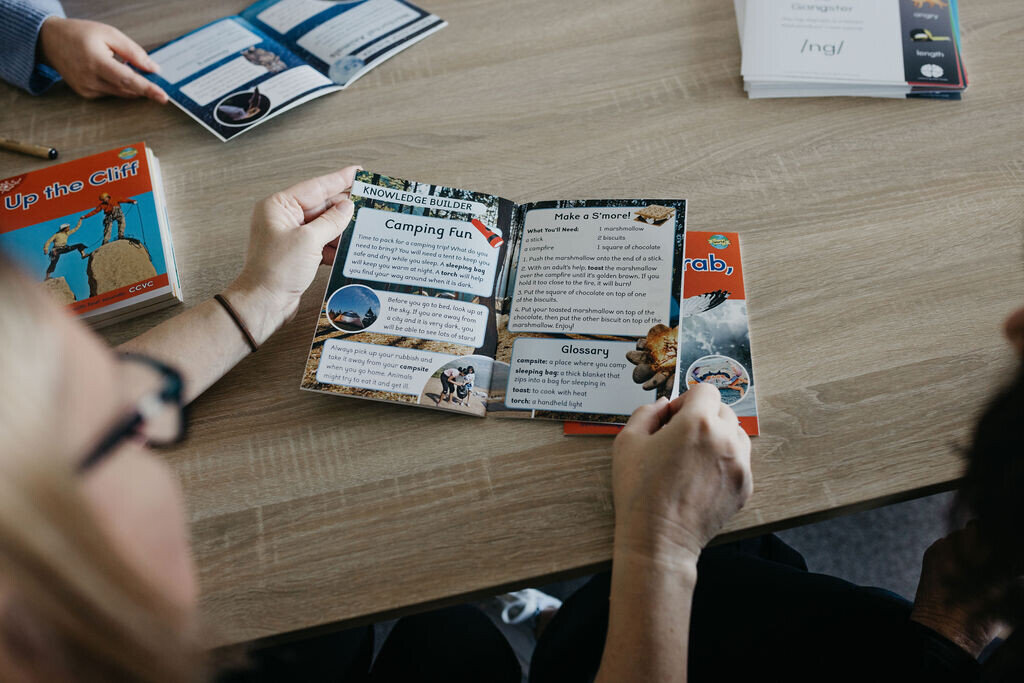Leap into Literacy
Bite-sized activities with Learning MATTERS
Providing bite-sized and practical foundational literacy activities you can do with your children.
These activities are based on the Building Blocks of Reading Success, which highlight the key elements that must be taught for reading success. We encourage you to view the videos in the progressive order we have listed below.
Further resources:
Chit Chat with Professor Pamela Snow - how are our children are being taught to learn to read?
#1 Phonological Awareness activities
Phonological awareness is a broad skill that includes identifying and manipulating units of oral language, i.e., syllables, and onsets and rimes. Phonological Awareness is away from print.
Further resources:
Chit Chat with Dr Carol Tolman - understanding phonological and phonemic awareness, alphabetic principle and connecting sounds to print.
#2 Phonemic Awareness activities
Phonemic awareness is the ability to hear, perceive, isolate, and manipulate the smallest units of spoken sound.
Phonemic awareness is a subset of phonological awareness.
#3 Alphabetic Principle activities
Understanding direct letter to sound/sound to letter correspondences of spelling patterns within syllable types and irregular spelling patterns.
These are successfully learnt by teaching through a scope and sequence (a teaching order from simple to complex). This step by step teaching enables the development of an expanding sight word vocabulary for instant, effortless reading of words. This video highlights the steps you might take when introducing basic code (letters) to your novice or struggling readers and writers.
Further resources:
Limited time only - FREE download of our iDeaL soundpack.
Chit Chat with Alison Clarke - how phonological awareness and the teaching of the code (systematically of course) aides reading fluency.
Sound Articulation demonstration video.
#4 Letter Formation and Handwriting
Teaching our children to correctly form their letters both supports their sound/symbol to letter correspondences and also enables them to write freely and with relative speed. This video highlights the importance of teaching handwriting as well as showing you ways to do this to build memory for movement and memory for sound to symbol associations.
Further resources:
#5 Spelling Rules explained
Research indicates that children will make the greatest progress in literacy when they are explicitly taught how our language system works. Teaching spelling rules from simple to complex in a structured manner has been identified as the most effective way to build foundation literacy skills. This video looks at the most common spelling rules and patterns that you may wish to support the learning of at home.
Further resources:
#6 Irregular Words
In this video we explain what irregular words are and how we learn them.
Irregular words are words used in the English language that do not follow sound to symbol association.
Further resources:
#7 Syllable Types
Teaching syllable types enables children to understand how words work. This is also prerequisite knowledge for syllable division which enables reading and spelling. In this video we will build your understanding of the seven syllable types.
Further resources:
#8 Syllable Division
We explain what syllable division is and how and why we learn them.
Further resources:
#9 Word Level Reading Fluency activities
Reading fluency is the ability to read words in a connected text with accuracy, appropriate speed, phrasing, and expression.
Further resources:
#10 Decodables vs Levelled text
It this activity we look at the differences between a decodable and a levelled text, and provide practical advice on how to use decodable texts.
Further resources:
#11 Decodable Texts
In this video we provide an example of reading with a decodable text and how children should be able to apply previously taught sound to letter correspondences, spelling rules and syllables types.
Further resources:
#12 Supporting Older Struggling Readers
In this activity we provide practical activities and advice to support your older struggling reader.
We look at word level reading and highlight older catch-up decodable texts.
Further resources:






